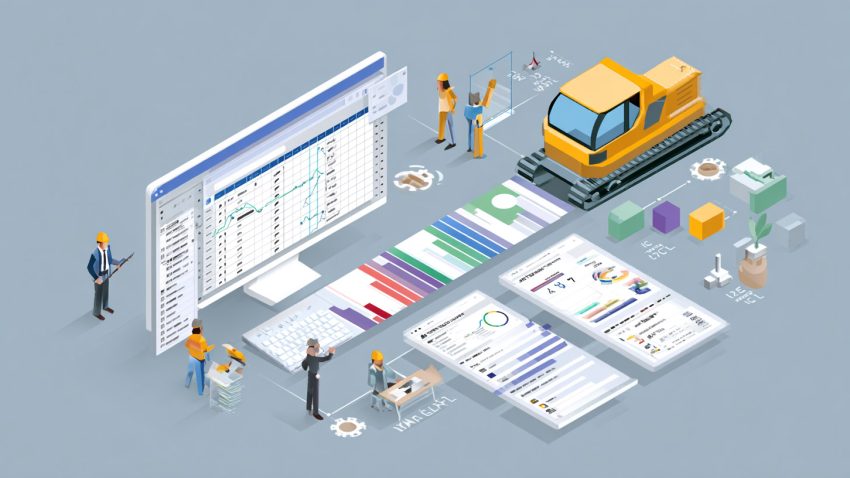From Blueprint to Building: Comprehensive Project Planning Strategies in Construction Management
Table of Contents:
When it comes to construction management, the journey from blueprint to building is filled with intricate planning, meticulous execution, and a relentless focus on detail. Effective project planning is the backbone of this journey, ensuring that every stage of construction runs smoothly and efficiently. Let’s dive into the comprehensive strategies that will take your project from the initial blueprints to the final construction, ensuring success every step of the way.

Imagine standing at the edge of a vast construction site, the smell of fresh earth in the air, and the hum of machinery in the background. It’s an exhilarating yet daunting sight, knowing that soon, a towering structure will rise from this very ground. But, before any bricks are laid or beams are hoisted, there’s a monumental amount of planning that must occur. This planning isn’t just about ensuring the right materials arrive on time or that labor is effectively managed; it’s about envisioning the entire lifecycle of the project and anticipating every challenge and opportunity that might arise.
In the fast-paced world of commercial construction, where deadlines are tight and budgets tighter, the importance of comprehensive project planning cannot be overstated. Delays and missteps can not only escalate costs but also tarnish reputations and strain client relationships. This is why a robust project planning strategy is the cornerstone of successful construction management. It’s the difference between a project that flounders and one that flourishes.
At the heart of effective project planning is the ability to transform abstract ideas into concrete plans.
This transformation begins with the blueprint stage, where the seeds of the project are planted. Blueprints are not just technical drawings; they are the physical representation of the vision for the project. They guide every subsequent decision, from the selection of materials to the deployment of labor. In this stage, thorough planning and attention to detail are paramount. Each line and notation on the blueprint must be meticulously considered, as they set the foundation for the entire project.
But creating a blueprint is just the beginning. The transition from blueprint to building involves a series of critical steps that ensure the project stays on track, within budget, and meets the expected quality standards. Pre-construction planning is the bridge that connects the theoretical aspects of the blueprint to the practical realities of construction. This phase involves detailed scheduling, budgeting, and resource allocation. It’s where the abstract becomes tangible, and the vision begins to take shape.
As construction commences, the focus shifts to execution and continuous monitoring. This is where the rubber meets the road. Effective on-site management is crucial, as is clear communication and collaboration among all stakeholders. Regular progress monitoring and reporting ensure that any deviations from the plan are promptly addressed, keeping the project on track.
Once the construction phase is complete, the project transitions into the post-construction phase.
This phase is about wrapping up and reflecting. Final inspections and approvals ensure that the project meets all regulatory and quality standards. A smooth handover process is crucial for client satisfaction, providing them with the necessary documentation and training to operate and maintain the building.
Finally, reflecting on the project’s successes and challenges provides valuable insights for future projects. This post-project review is essential for continuous improvement, helping teams to learn from their experiences and apply best practices in future endeavors.
From blueprint to building, the journey of a construction project is complex and multifaceted. Each phase is interconnected, and the success of the project relies on meticulous planning and execution at every step. By following these comprehensive strategies, you can ensure that your construction projects are completed on time, within budget, and to the highest standards of quality.
Related Articles:
Best Guide to Construction Management Software
The Best Guide to Delivery Management Systems (DMS) for Commercial Construction
45 Benefits and Tips of Construction Management Software for Superintendents
The Blueprint Stage: Laying the Foundation
The blueprint stage is where it all begins. This is where ideas are transformed into detailed plans that will guide the entire project. Here’s how to nail this crucial phase:
1. Initial Concept and Feasibility Study
Before the first line is drawn on a blueprint, a solid concept and feasibility study are essential. This involves:
- Defining Objectives: Clearly outline what the project aims to achieve. What are the primary goals? What constraints need to be considered?
- Feasibility Analysis: Assess the project’s viability by considering factors like site conditions, budget constraints, and regulatory requirements.
2. Detailed Design and Specifications
Once the feasibility is established, it’s time to dive into the detailed design:
- Architectural Blueprints: Develop comprehensive architectural plans that detail every aspect of the project.
- Engineering Plans: Coordinate with engineers to create structural, electrical, and mechanical plans.
- Specifications: Define the materials, standards, and workmanship required for the project.
Pre-Construction Planning: Getting Ready to Build
Pre-construction planning bridges the gap between the blueprints and the actual construction. This stage ensures everything is in place for a seamless start:
1. Project Scheduling
A well-thought-out schedule is the backbone of any successful construction project:
- Gantt Charts: Use Gantt charts to map out the project timeline, highlighting key milestones and deadlines.
- Critical Path Method (CPM): Identify the critical tasks that could impact the project’s completion date and ensure they are given priority.
2. Budgeting and Cost Estimation
Accurate budgeting and cost estimation are crucial to avoid financial pitfalls:
- Detailed Budget: Break down the budget into detailed line items, covering everything from materials to labor costs.
- Contingency Plans: Include a contingency budget to account for unexpected expenses.
3. Resource Allocation
Ensure you have the right resources in the right place at the right time:
- Labor and Equipment Planning: Schedule labor and equipment to ensure they are available when needed.
- Material Procurement: Plan the procurement of materials to avoid delays caused by supply chain issues.

Construction Phase: Bringing Plans to Life
As the blueprints are finalized and approved, the next phase of the project commences, where the focus shifts from planning to execution. This phase is marked by the implementation of strategies and the actualization of the vision laid out in the blueprints. It is a critical stage that requires meticulous coordination and effective communication among all stakeholders involved.
The execution phase typically starts with the mobilization of resources, including human capital, equipment, and materials, to the project site. Construction activities begin in earnest, and progress is monitored closely to ensure adherence to schedules and quality standards. This phase also involves regular inspections, testing, and quality control measures to guarantee that the final product meets the desired specifications.
Concurrent with the execution phase is the continuous monitoring of project progress. This involves tracking key performance indicators (KPIs), such as budget, timeline, and quality, to identify potential deviations from the plan. Regular progress reports are generated and communicated to stakeholders to keep them informed about the project’s status.
The execution phase also emphasizes risk management. Potential risks and challenges are identified and addressed promptly to minimize their impact on the project. This may involve contingency planning, mitigation strategies, and proactive risk management measures.
The execution phase is a crucial juncture in any project, as it brings the blueprints to life and transforms them into tangible outcomes. It requires a combination of technical expertise, strategic planning, and effective project management to ensure successful completion and delivery of the project within the specified parameters.
1. On-Site Management
Effective on-site management is key to keeping the project on track:
- Daily Briefings: Conduct daily briefings to ensure everyone is aware of their tasks and responsibilities.
- Quality Control: Implement strict quality control measures to ensure the work meets the required standards.
2. Communication and Collaboration
Clear communication and collaboration among all stakeholders are essential:
- Regular Meetings: Hold regular meetings with the project team, subcontractors, and clients to discuss progress and address any issues.
- Collaboration Tools: Use construction management software to facilitate real-time collaboration and information sharing.
3. Progress Monitoring and Reporting
Keep a close eye on the project’s progress to ensure it stays on schedule:
- Progress Reports: Generate regular progress reports to track milestones and identify any delays.
- Adjustments: Be prepared to make adjustments to the schedule or resources as needed to keep the project on track.

Post-Construction: Wrapping Up and Reflecting
The construction phase may be over, but the project isn’t complete until the final steps are taken:
1. Final Inspections and Approvals
Ensure the completed project meets all regulatory and quality standards:
- Inspections: Conduct thorough inspections to identify any defects or issues that need to be addressed.
- Approvals: Obtain the necessary approvals from regulatory bodies and the client.
2. Project Handover
A smooth handover is crucial for client satisfaction:
- Documentation: Provide the client with all necessary documentation, including as-built drawings, warranties, and maintenance manuals.
- Training: Offer training to the client’s team on the operation and maintenance of the building’s systems.
3. Post-Project Review
Reflecting on the project’s successes and challenges provides valuable insights for future projects:
- Review Meetings: Hold review meetings with the project team to discuss what went well and what could be improved.
- Lessons Learned: Document lessons learned and best practices to apply to future projects.
From Blueprint to Building Success
Mastering the journey from blueprint to building requires meticulous planning, seamless execution, and a commitment to continuous improvement. By following these comprehensive strategies, you can ensure your construction projects are completed on time, within budget, and to the highest standards of quality.
StruxHub is at the forefront of transforming construction management with its innovative, user-friendly platform designed to streamline operations, enhance on-site safety, and improve project efficiency. By integrating cutting-edge technology with practical, real-world applications, StruxHub provides a holistic solution to the complex challenges faced by today’s construction professionals. Our platform is built to ensure seamless collaboration, meticulous resource management, and unparalleled project oversight, making construction projects more manageable and predictable than ever before.
StruxHub’s Key Features and Benefits:
- Advanced Delivery Management: Automate and optimize your delivery schedules, ensuring materials arrive just in time, every time.
- Site Communication: Utilize georeferenced maps and instant messaging to keep every team member informed and aligned.
- Construction Materials Management: Track inventory levels and manage materials procurement with ease, reducing waste and avoiding project delays.
- Construction Safety & Inspection Workflows: Implement customizable mobile forms for conducting safety inspections and managing compliance documentation effortlessly.
- Short-Term Scheduling: Visualize project tasks with detailed floor plans, linking each activity to specific locations for better planning accuracy.
- Construction Resource Management: Efficiently allocate personnel and equipment, maximizing productivity and reducing idle time.
StruxHub’s Product Offering:
- StruxHub Deliveries: Simplifies the coordination of incoming deliveries, ensuring materials and equipment are precisely timed to project needs.
- StruxHub Logistics: Offers intelligent site logistics planning, from crane scheduling to space allocation, for smoother operations.
- StruxHub Safety: Elevates on-site safety standards with easy-to-use tools for inspections, permits, and incident reporting.
- StruxHub Scheduling: Enhances project timelines with intuitive scheduling tools that ensure tasks are completed efficiently and on time.
With StruxHub, construction companies can look forward to a streamlined, more efficient project execution that delivers on time and within budget. Embrace the power of innovation and take your construction projects to the next level.
Don’t miss out on the opportunity to optimize your construction management processes with StruxHub. Sign up for a free demo today. Let’s build smarter, together.



